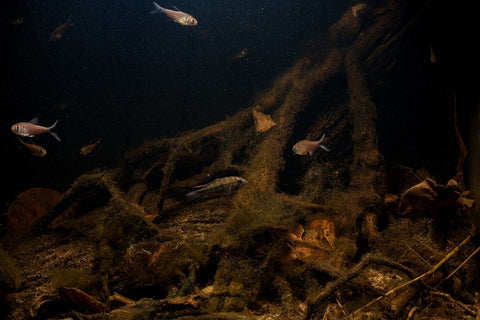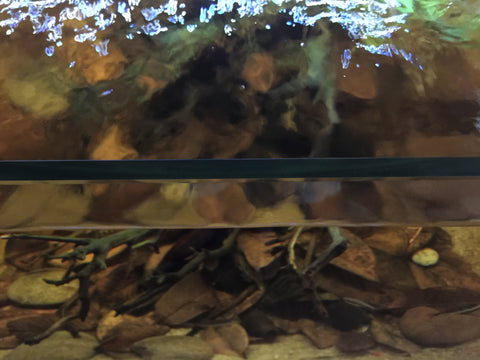- Continue Shopping
- Your Cart is Empty
The amazing power of you. And the immense value of "imperfection."
The other day, one of my favorite people in the fish world, Johnny Ciotti came by the office to pick up some stuff for a new project, check out our office aquarium, and just chat a bit. In addition to being incredibly talented, he's one of those aquarists who just "gets" it- he has a complete and thorough understanding of the philosophy of aesthetic, and an appreciation for keeping stuff simple.

His photography and marketing work has been utilized by a number of major aquarium product manufacturers, many of which you have probably seen over the years.

Although he's created some rather iconic 'scapes in his career, and is highly regarded in the freshwater and marine aquascaping arena, he'll be the first to tell you that you should 'scape for yourself.
As as typical when we get together, we chatted a bit about the state of the hobby, ideas, trends, technique, etc. After spending a good long time staring at our office aquarium, I could tell it touched him on some visceral level. John's a guy who doesn't just heap praise out for no reason, but he really was going on and on about our aquarium. It really touched him.

During our discussion, he said something that we both paused upon. "Your tank...this type of tank, is like...'easy'- if you let it be. It's not forced"
That was a big thing.
We both sort of built on that comment during our discussion. This is a theme that has been repeated by quite a few of our customers who have created "Botanical-Style" aquariums: Unlike a lot of highly stylized "Nature Aquariums", with very carefully laid out plants, definitive substrate borders, and precise ratios, the "Botanical-Style" aquarium is far more "free form", very relaxed. Not "forced" in any way. The idea being that to create a natural-looking aquarium, you start with a basic concept and let nature run its course.

In other words, you create a layout that appeals to you. Fill the aquarium with botanicals, wood, and plants as you see fit...and then let it "evolve." over time. You let the leaves soften and decompose. You allow the water to darken, the pods to start to crumble a bit, perhaps being moved in the current. Embrace the biofilms, the decomposition...the natural processes You replace decomposing leaves with new ones as you see fit. Let the plants "do their thing." It's the antithesis of the (IMHO) excessively "thought-out" styles that are so prevalent in today's aquascaping world.
Botanical-Style aquariums are the absolute embodiment of the Japanese philosophy of "wabi-sabi", which Takashi Amano used to cite rather often in his works. This philosophy accepts transience and imperfection, rather than fights it. The aesthetic is sometimes described as one of beauty that is "imperfect, impermanent, and incomplete."

This philosophy embraces natural process, doesn't attempt to overly manipulate or stylize it...and cherishes what could be seen as "imperfections" to many of those who seek precision and perfection. The idea of leaves and botanicals breaking down in our aquariums as in nature is that they become more interesting as they exhibit changes that can be observed over time. "Wabi-sabi" accepts that being surrounded by natural, changing, unique objects helps us connect to our real world and escape potentially stressful distractions. Imperfection has greater meditative value in this light.

We all start with a glass or acrylic box, hopes, ideas, and excitement. What we end up with depends largely upon our ability to "articulate" our visions. Some hobbyists are better at this than others, seemingly effortlessly creating beautiful aquariums each and every time.
Some of us (present company included) are a bit less talented in that department, and have to really push ourselves, wrack our brains to create an aquarium that satisfies our tastes and vision. To others, things come much more easily. Some of us are really, really good at picking the healthiest, most colorful fishes; the healthiest plants with great growth potential. Whatever. The "Botanical Style" aquarium levels the playing field, allowing us all to relax, let our guard down, and let things just "be."

It's not easy to accept or even grasp, especially to those of us raised in a very "Western" value system. It's downright "alien" to some. And yet, the idea of letting your aquascape evolve with minimal intervention after its initial setting is very appealing to many.

I'm always blown away by how some people just "get" this immediately after looking at an aquarium created in this fashion. They just sort of fall into this state of relaxed, almost meditative reflection. Others tend to look at one of these aquariums and think to themselves, "What a dirty, disorganized, undisciplined tank."
And that's kind of the beauty of aquascaping. There are styles for every taste. No "right" or "wrong." In my humble opinion, we've spent a lot of the last few decades creating "rules" and guidelines and "best practices" for seemingly every aspect of aquascaping.

For example, rather than simply following our aesthetic and letting materials "talk to us" when selecting them for use in an aquascape, enormous amounts of time and energy are spent trying to find a rock or piece of wood that will create that perfect ratio or composition that is consistent with some pre-judged "style" of aquarium.
And the result, IMHO, has been aquascaping contests filled with beautiful aquariums, 85% of which look nearly identical at first glance. I actually get a little sad when I see the entries in many of these global contests, because each one tries so hard to conform to some (IMHO) perverted interpretation of aquascaping "rules." I can't help but think that the hugely talented scapers who enter these contests (and thus influence popular aquascaping "culture" in the process) would be far better served to simply follow their own style, their own unique interpretation.

I think this is what Mr. Amano was proferring, but I can't help but wonder if just perhaps, somehow, his words, concepts, and ideas were misinterpreted somewhere along the line?

Perhaps embracing the "wabi-sabi" philosophy a bit more would create more effortless, evolving, and truly unique aquariums. And along with it, an aesthetic that truly taps into some deeper appreciation that we have for the natural world and all of its variation, texture, and imperfection.
We all have the power within ourselves to create beautiful aquariums...if we allow ourselves to simply relax and just be.
Today's somewhat deep, rather esoteric- and yet (I think) very important musings.
Stay bold. Stay creative. Sty true to yourself. Stay independent.
And Stay Wet.
Scott Fellman
Tannin Aquatics











Scott Fellman
Author